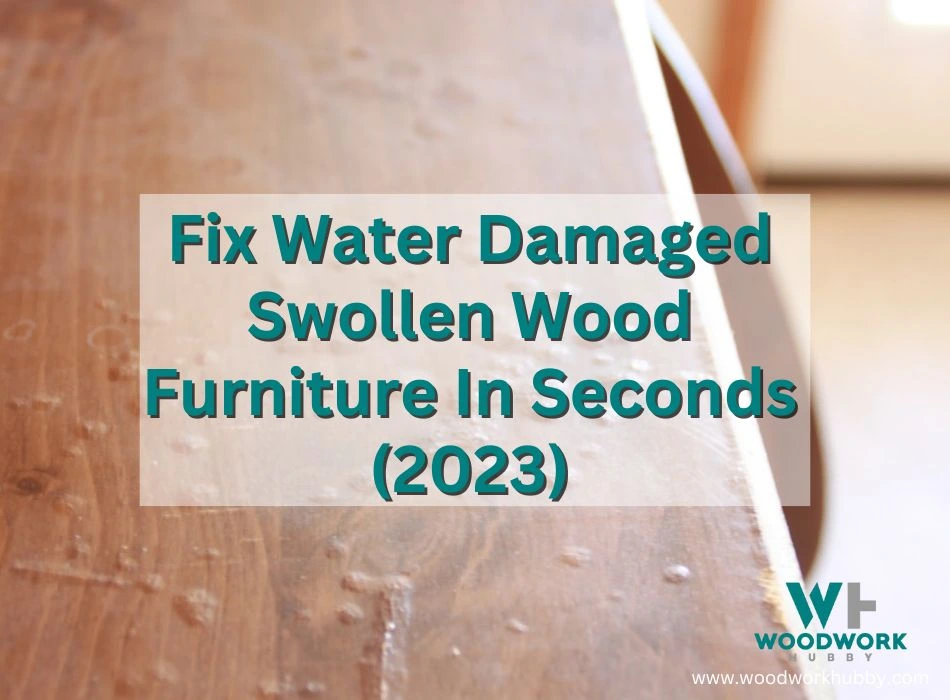Is your beautiful wooden furniture disfigured by unsightly water damage and swelling? I know how heart-wrenching it can be because I’ve been there too. Make no mistake; it’s a problem that has brought many wooden pieces to my shop, but luckily, I can easily show you how to fix water-damaged swollen wood furniture.
Key Takeaways
- Understanding why wood swells when exposed to water can help in preventing and treating water damage on wooden furniture.
- Steps to fix water-damaged swollen wood furniture include allowing the furniture to dry properly, using an iron or needle method to alleviate swelling, sanding and finishing the wood, and flattening any warped sections.
- Preventive measures such as applying oil finishes, sealing the wood, using stain-sealant products, and regularly applying a wood moisturizer can protect wooden furniture from water damage.
- Tips for using wooden furniture include using coasters, avoiding direct sunlight exposure, and promptly cleaning up spills.
Understanding the Causes and Effects of Water Damage on Wood Furniture
When wood furniture is exposed to water, it swells due to the absorption of moisture, leading to various consequences such as warping, cracking, and rotting.
Why wood swells when exposed to water
Water can find its way into the microscopic structures within wood, causing each cell to swell as it takes on moisture. This absorption process is influenced by factors such as relative humidity and the amount of time water remains in contact with the material.
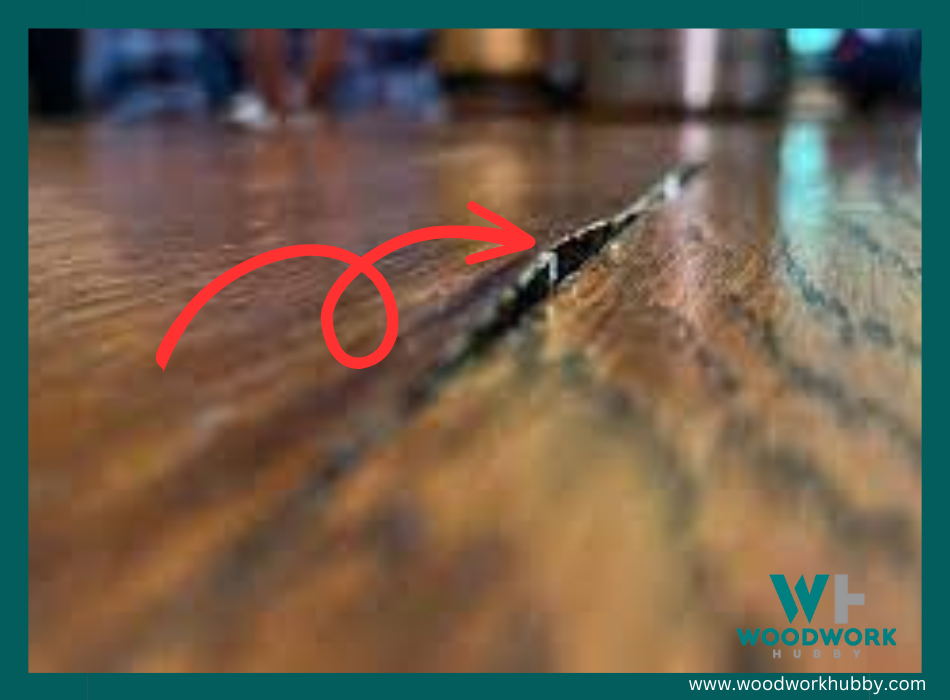
Noteworthy damage occurs when this swelling stretches the cells beyond their natural shape and size, leading to surface distortion or warping. In severe cases, longer exposure times can even lead to staining or grayish discoloration of the wood’s layers.
Different types of wood may react uniquely under these circumstances, therefore knowing why wood swells when exposed to water helps in understanding how best we can protect our wooden furniture from undue harm.
The consequences of water damage on wooden furniture
Water damage wreaks havoc on wooden furniture in various ways. The most immediate consequence is swelling, as wood tends to absorb moisture like a sponge. This can cause fitted components, such as drawers or doors, to become stuck due to increased size.
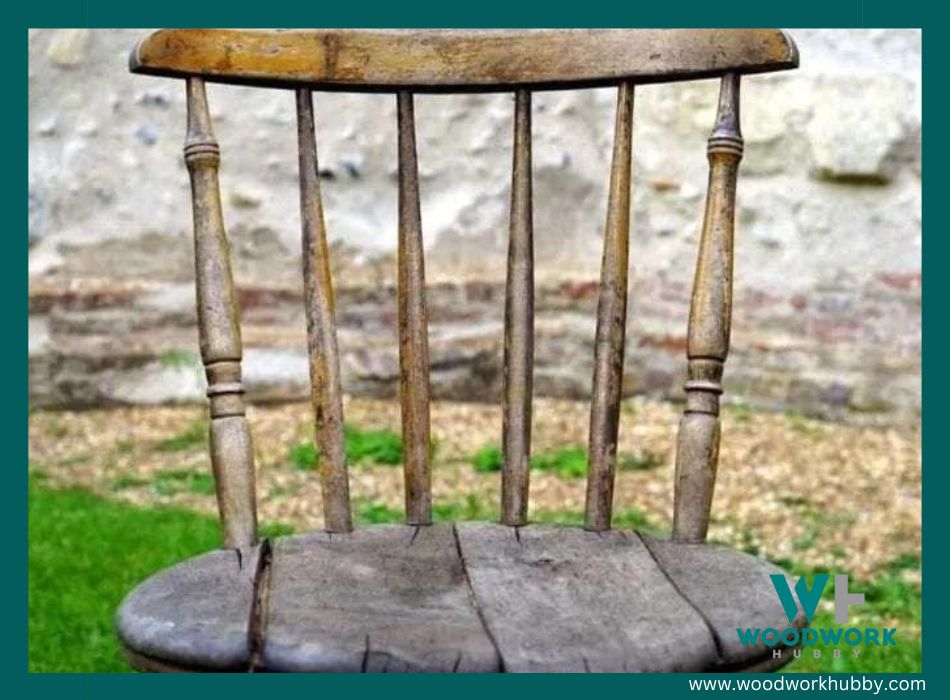
Unfortunately, once the water starts the drying process it may lead to further complications for your beloved piece of furniture. Distortion and warping often occur during fast drying periods and are visible signs that moisture has manipulated the shape of your furniture parts.
Severe cases might even display splitting or cracking – something nobody wants for their precious wooden items! It’s not all doom and gloom though; these damages don’t necessarily mean a trip to the waste disposal site for your wooden possessions.
With patience and care, water-damaged swollen wood furnishings can be restored back to their original conditions without hefty replacement costs!
Steps to Fix Water-Damaged Swollen Wood Furniture
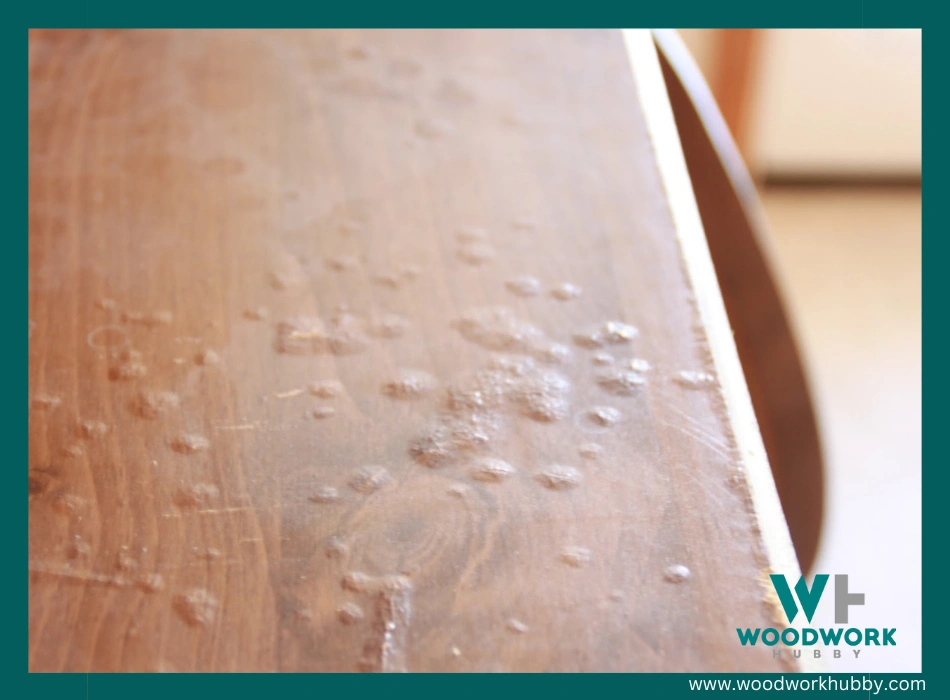
To fix water-damaged swollen wood furniture, start by allowing the furniture to dry completely before taking any further steps. Use an iron on a low setting to gently alleviate swelling in the wood.
If needed, use a needle or printer method to remove excess moisture from the affected areas. Once dry, sand and finish the wood to restore its original appearance. Finally, flatten any warped sections of the wood for a complete restoration.
Allowing the furniture to dry properly
Getting your wood furniture to dry properly is a crucial first step in tackling moisture damage. Here’s how you can ensure effective drying:
- Move the water-damaged furniture into the sun or a well-ventilated area. This promotes evaporation, helping the wood to dry faster.
- If it is not possible to place the furniture outside, consider getting a fan. Position the fan close to the furniture, allowing air circulation around every corner of it.
- Moisture-drenched furniture requires special attention. For such pieces, allocate a spot that gets ample ventilation, ideal for drying very wet wood.
- Patience is essential in this process. Wait until your water-damaged piece completely dries out before initiating any repair work. Rushing here can lead to poor restoration outcomes.
- A hairdryer can also be handy for speeding up the drying process of water-logged wooden parts.
Using an iron to alleviate swelling
To alleviate swelling in water-damaged swollen wood furniture, I recommend using an iron. Here’s how you can do it:
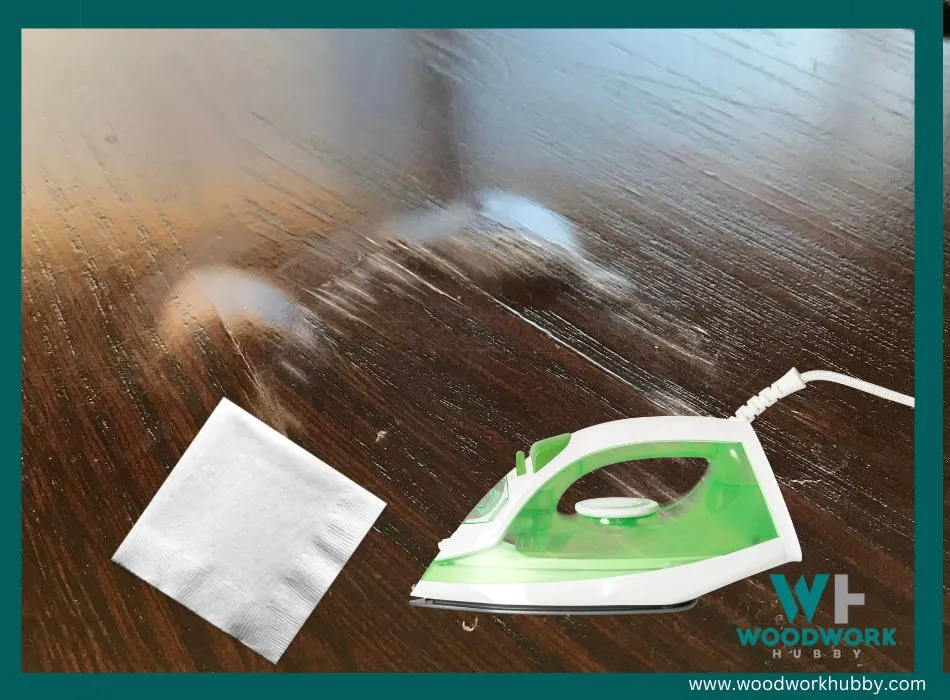
- Place a dry rag over the swollen area of the furniture.
- Set your iron to a low heat setting and turn off the steam function.
- Gently move the iron back and forth over the dry rag, applying light pressure.
- Keep moving the iron to prevent any heat damage to the wood.
- Continue this process until you start to see the swelling reduce.
- Be cautious not to leave the iron in one spot for too long, as it may cause discoloration or burn marks.
Needle or printer method for fixing water damage
To fix water damage on swollen wood furniture, you can try using a needle or a printer. Here’s how:
- Carefully insert a fine needle or pin into the swollen part of the wood.
- Gently move the needle around to release any trapped air or moisture.
- If you don’t have a needle, you can use a printer instead by setting it to its lowest setting and pressing it against the swollen area.
- The heat from the printer can help dry out the wood and reduce swelling.
Sanding and finishing the wood
To achieve a smooth and polished look after repairing water-damaged swollen wood furniture, I recommend the following steps:
- Sanding the wood using an electric sander with a 220 – grit sandpaper
- Ensuring that persistent stains are completely removed from the wood surface
- Applying a wood stain or paint to match the original color of the furniture
- Sealing the wood with a protective finish to prevent future water damage
- Buffing the surface with a polishing cloth to achieve a shiny and smooth appearance
Flattening the wood
Flattening the wood is a crucial step in repairing water-damaged swollen wood furniture. It helps restore the furniture to its original shape and appearance. Here are some effective ways to flatten the wood:
- Apply pressure: Use heavy objects like books or weights to press down on the swollen area. This will help compress the fibers in the wood and reduce swelling.
- Use clamps: Securely clamp the swollen wood between two flat surfaces, such as pieces of plywood or boards. Leave it clamped for several hours or overnight to allow the wood to flatten.
- Wetting and drying method: Moisten a cloth with water and place it over the swollen area. Then, use an iron set on low heat to apply gentle pressure and heat to the cloth. Move the iron in circular motions over the cloth for about 10-15 seconds at a time. Repeat this process until the wood starts to flatten.
- Steam treatment: Hold a steaming hot towel or iron close to but not directly touching the swollen area of the wood. The steam will penetrate into the wood fibers, causing them to expand and then contract as they cool down, helping to flatten out any bulges.
- Professional assistance: If your attempts to flatten the wood are unsuccessful, it may be best to seek professional help from a furniture restoration specialist who has experience dealing with water-damaged swollen wood.
Preventive Measures to Protect Wooden Furniture from Water Damage
To protect wooden furniture from water damage, apply oil finishes, seal the wood, use stain-sealant products, and apply a wood moisturizer.
Applying oil finishes
I highly recommend applying oil finishes to protect your wooden furniture from water damage. Not only do these finishes provide a protective layer, but they also enhance the overall appearance of the wood.
By using oil finishes, you can prevent water stains from causing dents or holes in the furniture. Additionally, cleaning water spots on wood furniture with turpentine is easier when an oil finish is applied.
Remember, sanding the damaged and swollen area of the wood can help repair water damage, even when oil finishes are used. Keep in mind that different types of sandpaper or sanding disks may be required for this process.
- Linseed oil
- Tung oil
- Turpentine (for cleaning water spots)
- Sandpaper or sanding disks (various grits)
Sealing the wood
To protect wooden furniture from water damage, it is crucial to seal the wood properly. Here are some preventive measures you can take:
- Applying oil finishes: Using linseed oil or other oil-based finishes can create a protective barrier on the surface of the wood, preventing water from seeping in.
- Sealing the wood: You can use a sealant specifically designed for wood furniture to ensure maximum protection against water damage. This sealant will create a waterproof layer that keeps moisture out.
- Using stain-sealant products: There are various stain-sealant products available in the market that not only enhance the appearance of your wooden furniture but also provide added protection against water damage.
- Applying a wood moisturizer: Using a wood moisturizer regularly helps to maintain the moisture balance in the wood and prevent it from becoming too dry or absorbing excess moisture.
Using stain-sealant products
I highly recommend using stain-sealant products to protect your wooden furniture from water damage. These products create a protective barrier that seals the wood and prevents moisture from seeping in.
By applying a stain-sealant, you can effectively waterproof your furniture and ensure its longevity. Additionally, these products act as a moisture barrier, making the wood resistant to swelling or warping caused by water exposure.
Applying a surface sealant or varnish to damp or damaged swollen wood is also an effective way to protect the furniture.
Applying a wood moisturizer
To protect your wooden furniture from water damage, it is important to regularly apply a wood moisturizer. This preventive measure helps prevent the wood from drying out and cracking, while also enhancing its natural beauty.
By creating a protective barrier on the surface of the wood, the moisturizer makes it more resistant to water penetration. This is particularly important if your furniture is in an environment with high humidity or frequent exposure to water.
Regularly applying a wood moisturizer can extend the lifespan of your wooden furniture and keep it looking its best.
Tips for Using Wooden Furniture and Avoiding Water Damage
To ensure the longevity of your wooden furniture and prevent water damage, incorporating daily habits like using coasters and avoiding direct sunlight can make a significant difference.
Discover more tips to keep your furniture in pristine condition by reading on.
Daily habits to prevent water damage
To prevent water damage to your wooden furniture, there are some daily habits you can follow:
- Wipe up spills immediately using a dry cloth or paper towel.
- Use coasters or placemats to protect the surface of your furniture from moisture.
- Avoid placing hot or cold items directly on the wood surface.
- Keep your furniture away from windows or areas prone to water leaks.
- Use a humidifier in dry climates to maintain consistent moisture levels in the air.
- Regularly inspect your furniture for any signs of water damage and address them promptly.
- Place furniture pads underneath objects that may scratch or cause dents in the wood.
Cleaning wooden furniture without causing damage
I take great care in cleaning my wooden furniture to ensure that it remains in pristine condition. Here are some tips I follow to clean wooden furniture without causing any damage:
- Use a soft, lint-free cloth or microfiber cloth to gently dust the surface of the furniture. This helps to remove any loose dirt or debris without scratching the wood.
- Avoid using harsh chemicals or abrasive cleaners on wooden furniture. Instead, opt for a mild soap solution mixed with warm water. Dampen the cloth with this solution and wring out any excess moisture before wiping down the furniture.
- When wiping down the furniture, always move in the direction of the wood grain. This helps to prevent any potential scratches or marks from appearing on the surface.
- For stubborn stains, create a paste by mixing baking soda with water and applying it directly to the stained area. Let it sit for a few minutes before gently scrubbing it with a soft cloth or sponge. Rinse thoroughly and dry immediately.
- To restore shine and luster to your wooden furniture, apply a small amount of wood polish or beeswax polish using a clean cloth. Buff the surface in circular motions until it shines.
Preventing cracks from spreading in wood
To prevent cracks from spreading in wood, it is important to take certain measures. Here are some tips for using wooden furniture and avoiding water damage:
- Regularly inspect your wooden furniture for any signs of cracks or damage.
- Avoid placing hot or cold items directly on the wood surface, as extreme temperatures can cause the wood to expand or contract and lead to cracking.
- Use coasters or placemats under glasses, cups, and other beverages to protect the wood from moisture.
- Clean up spills immediately to prevent liquid from seeping into the wood and causing swelling or warping.
- Avoid exposing wooden furniture to direct sunlight for long periods of time, as this can lead to drying out of the wood and increase the risk of cracking.
- Apply a protective finish, such as wax or varnish, to seal the wood and reduce its vulnerability to moisture damage.
- Keep indoor humidity levels between 40% and 60% to maintain a stable environment for the wood.
- When moving or transporting wooden furniture, handle it with care to avoid any impact or stress that could result in cracks.
Conclusion: Restoration Done Offers Water Damage Repair Services for Wood Furniture
In conclusion, when it comes to fixing water-damaged swollen wood furniture, taking immediate action is key. By understanding the causes and effects of water damage on wooden furniture, we can effectively prevent and treat it.
Implementing preventive measures and adopting proper cleaning habits will help safeguard our wooden furniture from future damage. And if all else fails, Restoration Done offers professional water damage repair services for wood furniture restoration.
Don’t let water damage ruin your beloved pieces – take the necessary steps to restore their beauty and functionality.
FAQs
1. Can water-damaged swollen wood furniture be repaired?
Water damaged swollen wood furniture can be repaired with the right techniques and tools. However, the extent of the damage will determine the complexity of the repair process.
2. What should I do immediately after discovering water damage on my wooden furniture?
After discovering water damage on your wooden furniture, it is important to remove any excess moisture by blotting with towels or using a wet/dry vacuum. Then, allow the furniture to dry completely before attempting any repairs.
3. How can I fix a swollen area on my wood furniture caused by water damage?
To fix a swollen area on wood furniture caused by water damage, you can try using a dehumidifier or placing fans nearby to speed up the drying process. If that doesn’t work, gently sand down the swollen area until it is even with the surrounding surface, and then refinish or repaint as needed.
4. Is it necessary to hire a professional for repairing water-damaged wooden furniture?
The decision to hire a professional for repairing water-damaged wooden furniture depends on your comfort level and expertise in woodworking. While some minor damages can be fixed DIY-style, more extensive repairs may require professional help to ensure proper restoration without further damaging your furniture.

